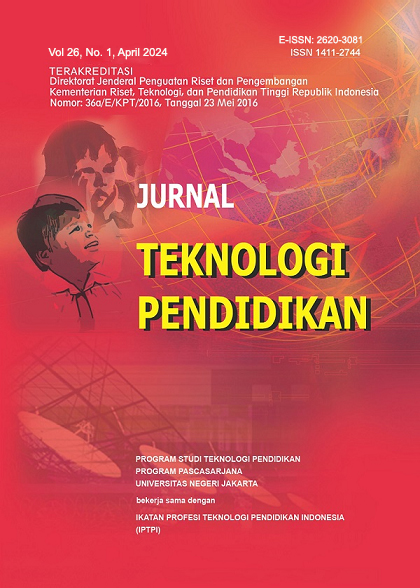Junior High School Student Models in Online Learning as A Post-Covid Effect
DOI:
https://doi.org/10.21009/jtp.v26i1.37560Keywords:
online learning, learning strategies, student profileAbstract
Online learning was one of the preferred learning strategies during the COVID-19 pandemic. Changes in learning orientation that was very fast with little coercion due to the limitations of face-to-face learning make educational institutions design appropriate learning strategies. Students as one learning component certainly try to adjust their activities in online learning. The process of adapting to online learning often causes failure in the learning process because of their unpreparedness for online learning. Finding a suitable role model in the process of adapting to online learning was a problem in this study. This study aims to design student models in online learning during the learning process. This study method uses a data visualization approach with data mining and involves as many as 350 students from various junior high schools in Malang. The results showed that there were differences in students' tendencies towards the choice of online learning platforms. In addition, skills in using technology are a determining factor in the formation of student profiles. Implementation of study results is one of the keys to the development of online learning in the future.
References
Ambarwati, R., Harja, Y. D., & Thamrin, S. (2020). The Role of Facilitating Conditions and User Habits: A Case of Indonesian Online Learning Platform. Journal of Asian Finance, Economics and Business, 7(10), 481–489. https://doi.org/10.13106/jafeb.2020.vol7.no10.481
A’yun, K., Suharso, P., & Kantun, S. (2021). Google Classroom as the Online Learning Platform during he Covid-19 Pandemic for the Management Business Student at SMK Negeri 1 Lumajang. IOP Conference Series: Earth and Environmental Science, 747(1). https://doi.org/10.1088/1755-1315/747/1/012025
Bouilheres, F., Le, L. T. V. H., Mcdonald, S., Nkhoma, C., & Jandug-Montera, L. (2020). Defining student learning experience through blended learning. Education and Information Technologies, 25, 3049–3069. https://doi.org/https://doi.org/10.1007/s10639-020-10100-y
Cakrawati, L. M. (2017). The Effect of Digital Flashcard on Students’ Vovabulary Mastery of the Fourth Grade Students at SD Negeri 1 & 2 Paket Agung in the Academic Year 2016/2017. ELT-Tech Journal, 1(1), 22–30.
Geng, S., Law, K. M. Y., & Niu, B. (2019). Investigating self-directed learning and technology readiness in blending learning environment. International Journal of Educational Technology in Higher Education, 16(1), 1–22. https://doi.org/10.1186/s41239-019-0147-0
Gherhes, V., Stoian, C. E., Fărcasiu, M. A., & Stanici, M. (2021). E-Learning vs . Face-To-Face Learning : Analyzing Students ’ Preferences and Behaviors. Sustainability, 13(4381), 1–15. https://doi.org/. https:// doi.org/10.3390/su13084381
Kentnor, H. (2015). Distance Education and the Evolution of Online Learning in the United States. Curriculum and Teaching Dialogue, 17(1), 22–34.
Kohnke, L., & Moorhouse, B. L. (2022). Facilitating synchronous online language learning through Zoom. Relc Journal, 53(1), 296–301. https://doi.org/10.1177/0033688220937235
Marsiding, Z. (2021). Efektifitas Penggunaan Media Zoom Terhadap Pembelajaran Pada Masa Pandemi Covid-19. Jurnal Ilmiah Pranata Edu, 2(1), 33–39. https://doi.org/10.36090/jipe.v2i1.931
Moonma, J. (2021). Google Classroom: Understanding EFL Students’ Attitudes towards Its Use as an Online Learning Platform. English Language Teaching, 14(11), 38. https://doi.org/10.5539/elt.v14n11p38
Oliwa, R. (2021). The Process of Designing the Functionalities of an Online Learning Platform – a Case Study. Teaching English with Technology, 21(3), 101–120.
Park, C., & Kim, D. (2020). Perception of instructor presence and its effects on learning experience in online classes. Journal of Information Technology Education: Research, 19, 475–488. https://doi.org/10.28945/4611
Sarkar, S. (2020). A Brief History of Online Education | Adamas University. In Adamas University (pp. 1–5).
Setiadi, P. M., Alia, D., Sumardi, S., Respati, R., & Nur, L. (2021). Synchronous or asynchronous? Various online learning platforms studied in Indonesia 2015-2020. Journal of Physics: Conference Series, 1987(1). https://doi.org/10.1088/1742-6596/1987/1/012016
UNICEF. (2020). Strengthening Digital Learning across Indonesia : A Study Brief.
Villa, S. C. (2022a). Investigating the Effect of Technology Readiness on Self Efficacy and Learning in Computer-Supported Learning Environments. In Arizona State University: Vol. May.
Villa, S. C. (2022b). Investigating the Effect of Technology Readiness on Self Efficacy and Learning in Computer-Supported Learning Environments. Arizona State University.
Warden, C. A., Yi-Shun, W., Stanworth, J. O., & Chen, J. F. (2022). Millennials’ technology readiness and self-efficacy in online classes. Innovations in Education and Teaching International, 59(2), 226–236. https://doi.org/14703297.2020.1798269
Wulan Sari, N. W., Wulansari, T. T., Yanuartha, W., Sipayung, M. S., & Pribadi, A. S. (2021). Factors Which Influence the Success of Google Classroom Based on Age. Journal of Physics: Conference Series, 1807(1). https://doi.org/10.1088/1742-6596/1807/1/012016
Zimmerman, W. A. (2016). Online Learning Self-Efficacy in Students With and Without Online Learning Experience. American Journal of Distance Education, 30(3), 180–191. https://doi.org/10.1080/08923647.2016.1193801
Downloads
Published
How to Cite
Issue
Section
License
Jurnal Teknologi Pendidikan is an Open Access Journal. The authors who publish the manuscript in Jurnal Teknologi Pendidikan agree to the following terms.
Attribution-ShareAlike 4.0 International (CC BY-SA 4.0)
-
Attribution — You must give appropriate credit, provide a link to the license, and indicate if changes were made. You may do so in any reasonable manner, but not in any way that suggests the licensor endorses you or your use.
-
ShareAlike — If you remix, transform, or build upon the material, you must distribute your contributions under the same license as the original.
- No additional restrictions — You may not apply legal terms or technological measures that legally restrict others from doing anything the license permits.
Notices:
- You do not have to comply with the license for elements of the material in the public domain or where your use is permitted by an applicable exception or limitation.
- No warranties are given. The license may not give you all of the permissions necessary for your intended use. For example, other rights such as publicity, privacy, or moral rights may limit how you use the material.








